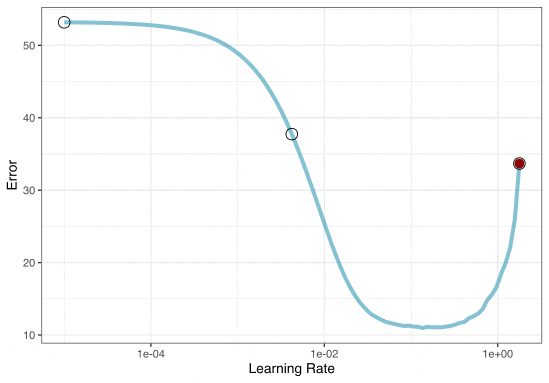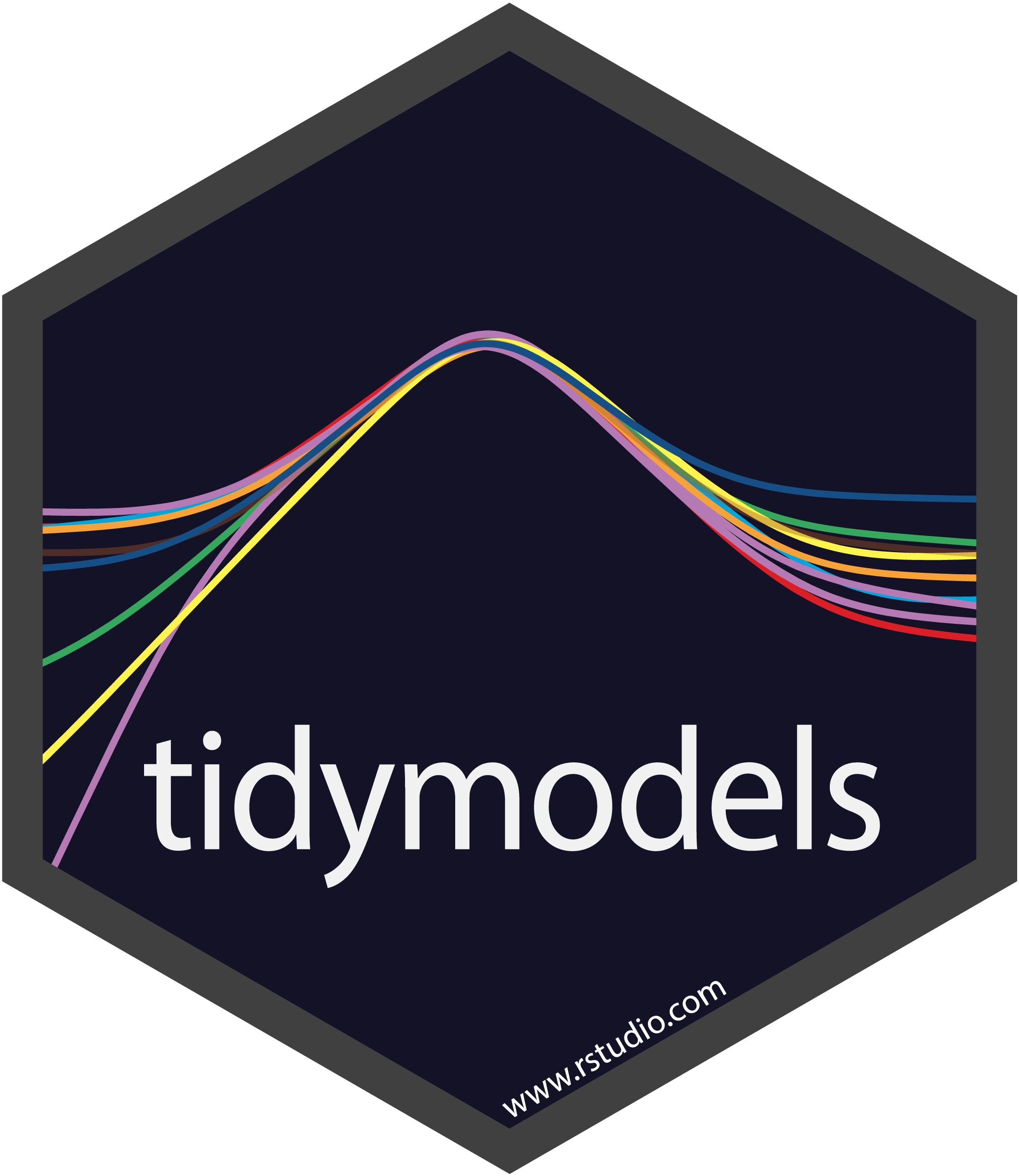3 - Tuning Hyperparameters
Advanced tidymodels
Previously - Setup ![]()
Previously - Data Usage ![]()
Previously - Feature engineering ![]()
![]()
library(textrecipes)
hash_rec <-
recipe(avg_price_per_room ~ ., data = hotel_train) |>
step_YeoJohnson(lead_time) |>
# Defaults to 32 signed indicator columns
step_dummy_hash(agent) |>
step_dummy_hash(company) |>
# Regular indicators for the others
step_dummy(all_nominal_predictors()) |>
step_zv(all_predictors())Optimizing Models via Tuning Parameters
Tuning parameters
Some model or preprocessing parameters cannot be estimated directly from the data.
Some examples:
- Tree depth in decision trees
- Number of neighbors in a K-nearest neighbor model
Activation function in neural networks?
Sigmoidal functions, ReLu, etc.
Yes, it is a tuning parameter. ✅
Number of feature hashing columns to generate?
Yes, it is a tuning parameter. ✅
Bayesian priors for model parameters?
Hmmmm, probably not. These are based on prior belief. ❌
The random seed?
Nope. It is not. ❌
Optimize tuning parameters
- Try different values and measure their performance.
- Find good values for these parameters.
- Once the value(s) of the parameter(s) are determined, a model can be finalized by fitting the model to the entire training set.
Tagging parameters for tuning ![]()
With tidymodels, you can mark the parameters that you want to optimize with a value of tune().
The function itself just returns… itself:
For example…
Optimizing the hash features ![]()
![]()
![]()
Our new recipe is:
We will be using a tree-based model in a minute.
- The other categorical predictors are left as-is.
- That’s why there is no
step_dummy().
Boosted Trees
These are popular ensemble methods that build a sequence of tree models.
Each tree uses the results of the previous tree to better predict samples, especially those that have been poorly predicted.
Each tree in the ensemble is saved and new samples are predicted using a weighted average of the votes of each tree in the ensemble.
We’ll focus on the popular lightgbm implementation.
Boosted Tree Tuning Parameters
Some possible parameters:
mtry: The number of predictors randomly sampled at each split (in \([1, ncol(x)]\) or \((0, 1]\)).trees: The number of trees (\([1, \infty]\), but usually up to thousands)min_n: The number of samples needed to further split (\([1, n]\)).learn_rate: The rate that each tree adapts from previous iterations (\((0, \infty]\), usual maximum is 0.1).stop_iter: The number of iterations of boosting where no improvement was shown before stopping (\([1, trees]\))
Boosted Tree Tuning Parameters
TBH it is usually not difficult to optimize these models.
Often, there are multiple candidate tuning parameter combinations that have very good results.
To demonstrate simple concepts, we’ll look at optimizing the number of trees in the ensemble (between 1 and 100) and the learning rate (\(10^{-5}\) to \(10^{-1}\)).
Boosted Tree Tuning Parameters ![]()
![]()
![]()
We’ll need to load the bonsai package. This has the information needed to use lightgbm
Optimize tuning parameters
The main two strategies for optimization are:
Grid search 💠 which tests a pre-defined set of candidate values
Iterative search 🌀 which suggests/estimates new values of candidate parameters to evaluate
Grid search
A small grid of points trying to minimize the error via learning rate:
Grid search
In reality we would probably sample the space more densely:
Iterative Search
We could start with a few points and search the space:

Grid Search
Parameters
The tidymodels framework provides pre-defined information on tuning parameters (such as their type, range, transformations, etc).
The
extract_parameter_set_dials()function extracts these tuning parameters and the info.
Grids
Create your grid manually or automatically.
The
grid_*()functions can make a grid.
Different types of grids ![]()
Space-filling designs (SFD) attempt to cover the parameter space without redundant candidates. We recommend these the most.
Create a grid ![]()
![]()
A parameter set can be updated (e.g. to change the ranges).
Create a grid ![]()
![]()
grid <-
lgbm_wflow |>
extract_parameter_set_dials() |>
grid_space_filling(size = 25)
grid
#> # A tibble: 25 × 4
#> trees learn_rate `agent hash` `company hash`
#> <int> <dbl> <int> <int>
#> 1 1 7.50e- 6 574 574
#> 2 84 1.78e- 5 2048 2298
#> 3 167 5.62e-10 1824 912
#> 4 250 4.22e- 5 3250 512
#> 5 334 1.78e- 8 512 2896
#> 6 417 1.33e- 3 322 1625
#> 7 500 1 e- 1 1448 1149
#> 8 584 1 e- 7 1290 256
#> 9 667 2.37e-10 456 724
#> 10 750 1.78e- 2 645 322
#> # ℹ 15 more rowsYour turn

Create a grid for our tunable workflow.
Try creating a regular grid.
03:00
Create a regular grid ![]()
![]()
grid <-
lgbm_wflow |>
extract_parameter_set_dials() |>
grid_regular(levels = 4)
grid
#> # A tibble: 256 × 4
#> trees learn_rate `agent hash` `company hash`
#> <int> <dbl> <int> <int>
#> 1 1 0.0000000001 256 256
#> 2 667 0.0000000001 256 256
#> 3 1333 0.0000000001 256 256
#> 4 2000 0.0000000001 256 256
#> 5 1 0.0000001 256 256
#> 6 667 0.0000001 256 256
#> 7 1333 0.0000001 256 256
#> 8 2000 0.0000001 256 256
#> 9 1 0.0001 256 256
#> 10 667 0.0001 256 256
#> # ℹ 246 more rowsYour turn

What advantage would a regular grid have?
Update parameter ranges ![]()
![]()
lgbm_param <-
lgbm_wflow |>
extract_parameter_set_dials() |>
update(trees = trees(c(1L, 100L)),
learn_rate = learn_rate(c(-5, -1)))
grid <-
lgbm_param |>
grid_space_filling(size = 25)
grid
#> # A tibble: 25 × 4
#> trees learn_rate `agent hash` `company hash`
#> <int> <dbl> <int> <int>
#> 1 1 0.00147 574 574
#> 2 5 0.00215 2048 2298
#> 3 9 0.0000215 1824 912
#> 4 13 0.00316 3250 512
#> 5 17 0.0001 512 2896
#> 6 21 0.0147 322 1625
#> 7 25 0.1 1448 1149
#> 8 29 0.000215 1290 256
#> 9 34 0.0000147 456 724
#> 10 38 0.0464 645 322
#> # ℹ 15 more rowsThe results ![]()
![]()
Note that the learning rates are uniform on the log-10 scale and this shows 2 of 4 dimensions.
Use the tune_*() functions to tune models
Choosing tuning parameters ![]()
![]()
![]()
![]()
![]()
Let’s take our previous model and tune more parameters:
lgbm_spec <-
boost_tree(trees = tune(), learn_rate = tune(), min_n = tune()) |>
set_mode("regression") |>
set_engine("lightgbm", num_threads = 1)
lgbm_wflow <- workflow(hash_rec, lgbm_spec)
# Update the feature hash ranges (log-2 units)
lgbm_param <-
lgbm_wflow |>
extract_parameter_set_dials() |>
update(`agent hash` = num_hash(c(3, 8)),
`company hash` = num_hash(c(3, 8)))Grid Search ![]()
![]()
![]()
Grid Search ![]()
![]()
![]()
lgbm_res
#> # Tuning results
#> # 10-fold cross-validation using stratification
#> # A tibble: 10 × 5
#> splits id .metrics .notes .predictions
#> <list> <chr> <list> <list> <list>
#> 1 <split [3372/377]> Fold01 <tibble [50 × 9]> <tibble [0 × 4]> <tibble [9,425 × 9]>
#> 2 <split [3373/376]> Fold02 <tibble [50 × 9]> <tibble [0 × 4]> <tibble [9,400 × 9]>
#> 3 <split [3373/376]> Fold03 <tibble [50 × 9]> <tibble [0 × 4]> <tibble [9,400 × 9]>
#> 4 <split [3373/376]> Fold04 <tibble [50 × 9]> <tibble [0 × 4]> <tibble [9,400 × 9]>
#> 5 <split [3373/376]> Fold05 <tibble [50 × 9]> <tibble [0 × 4]> <tibble [9,400 × 9]>
#> 6 <split [3374/375]> Fold06 <tibble [50 × 9]> <tibble [0 × 4]> <tibble [9,375 × 9]>
#> 7 <split [3375/374]> Fold07 <tibble [50 × 9]> <tibble [0 × 4]> <tibble [9,350 × 9]>
#> 8 <split [3376/373]> Fold08 <tibble [50 × 9]> <tibble [0 × 4]> <tibble [9,325 × 9]>
#> 9 <split [3376/373]> Fold09 <tibble [50 × 9]> <tibble [0 × 4]> <tibble [9,325 × 9]>
#> 10 <split [3376/373]> Fold10 <tibble [50 × 9]> <tibble [0 × 4]> <tibble [9,325 × 9]>Grid results ![]()
Tuning results ![]()
collect_metrics(lgbm_res)
#> # A tibble: 50 × 11
#> trees min_n learn_rate `agent hash` `company hash` .metric .estimator mean n std_err .config
#> <int> <int> <dbl> <int> <int> <chr> <chr> <dbl> <int> <dbl> <chr>
#> 1 1500 21 0.00000000316 8 60 mae standard 53.2 10 0.427 pre01_mod19_post0
#> 2 1500 21 0.00000000316 8 60 rsq standard 0.809 10 0.00661 pre01_mod19_post0
#> 3 917 16 0.0422 9 39 mae standard 9.85 10 0.150 pre02_mod12_post0
#> 4 917 16 0.0422 9 39 rsq standard 0.946 10 0.00362 pre02_mod12_post0
#> 5 584 13 0.0000001 10 10 mae standard 53.2 10 0.427 pre03_mod08_post0
#> 6 584 13 0.0000001 10 10 rsq standard 0.810 10 0.00745 pre03_mod08_post0
#> 7 167 19 0.00000133 12 143 mae standard 53.2 10 0.426 pre04_mod03_post0
#> 8 167 19 0.00000133 12 143 rsq standard 0.811 10 0.00698 pre04_mod03_post0
#> 9 1583 33 0.0000422 14 12 mae standard 50.3 10 0.405 pre05_mod20_post0
#> 10 1583 33 0.0000422 14 12 rsq standard 0.817 10 0.00768 pre05_mod20_post0
#> # ℹ 40 more rowsTuning results ![]()
collect_metrics(lgbm_res, summarize = FALSE)
#> # A tibble: 500 × 10
#> id trees min_n learn_rate `agent hash` `company hash` .metric .estimator .estimate .config
#> <chr> <int> <int> <dbl> <int> <int> <chr> <chr> <dbl> <chr>
#> 1 Fold01 1500 21 0.00000000316 8 60 mae standard 51.8 pre01_mod19_post0
#> 2 Fold01 1500 21 0.00000000316 8 60 rsq standard 0.805 pre01_mod19_post0
#> 3 Fold02 1500 21 0.00000000316 8 60 mae standard 52.1 pre01_mod19_post0
#> 4 Fold02 1500 21 0.00000000316 8 60 rsq standard 0.800 pre01_mod19_post0
#> 5 Fold03 1500 21 0.00000000316 8 60 mae standard 52.2 pre01_mod19_post0
#> 6 Fold03 1500 21 0.00000000316 8 60 rsq standard 0.783 pre01_mod19_post0
#> 7 Fold04 1500 21 0.00000000316 8 60 mae standard 51.7 pre01_mod19_post0
#> 8 Fold04 1500 21 0.00000000316 8 60 rsq standard 0.818 pre01_mod19_post0
#> 9 Fold05 1500 21 0.00000000316 8 60 mae standard 55.2 pre01_mod19_post0
#> 10 Fold05 1500 21 0.00000000316 8 60 rsq standard 0.845 pre01_mod19_post0
#> # ℹ 490 more rowsChoose a parameter combination ![]()
show_best(lgbm_res, metric = "rsq")
#> # A tibble: 5 × 11
#> trees min_n learn_rate `agent hash` `company hash` .metric .estimator mean n std_err .config
#> <int> <int> <dbl> <int> <int> <chr> <chr> <dbl> <int> <dbl> <chr>
#> 1 1250 9 0.1 107 80 rsq standard 0.947 10 0.00395 pre19_mod16_post0
#> 2 917 16 0.0422 9 39 rsq standard 0.946 10 0.00362 pre02_mod12_post0
#> 3 1666 30 0.00750 124 19 rsq standard 0.943 10 0.00309 pre20_mod21_post0
#> 4 2000 24 0.00133 25 124 rsq standard 0.919 10 0.00383 pre09_mod25_post0
#> 5 500 25 0.00316 52 8 rsq standard 0.899 10 0.00435 pre14_mod07_post0Choose a parameter combination ![]()
Create your own tibble for final parameters or use one of the tune::select_*() functions:
Checking Calibration ![]()
![]()
Running in parallel
Grid search, combined with resampling, requires fitting a lot of models!
These models don’t depend on one another and can be run in parallel.
We can use a parallel backend to do this:
Running in parallel
Speed-ups are fairly linear up to the number of physical cores (10 here).
The ‘future’ of parallel processing
We have relied on the foreach package for parallel processing.
We will start the transition to using the future package in the upcoming version of the tune package (version 1.3.0).
There will be a period of backward compatibility where you can still use foreach with future via the doFuture package. After that, the transition to future will occur.
Overall, there will be minimal changes to your code.
Early stopping for boosted trees
We have directly optimized the number of trees as a tuning parameter.
Instead we could
- Set the number of trees to a single large number.
- Stop adding trees when performance gets worse.
This is known as “early stopping” and there is a parameter for that: stop_iter.
Early stopping has a potential to decrease the tuning time.
Your turn

Set trees = 2000 and tune the stop_iter parameter.
Note that you will need to regenerate lgbm_param with your new workflow!
10:00










